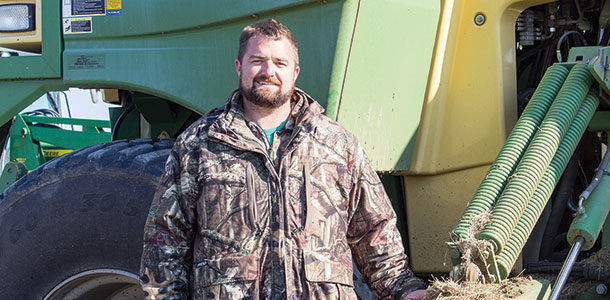Braxton was a typical Georgian row-crop farmer up until 2011, but his business focus changed when a grass-based dairy moved into the area.
“They needed hay and baleage to feed their cows over winter, and we had some harvesting equipment to do the job,” Braxton says.
Braxton owned the only balers in the area with knives capable of chopping hay. Six hundred acres of grass were harvested for the dairy farm in 2011, and the harvesting business has flourished since.
Braxton’s soybean and corn farming has become second place to the growing harvesting operation. This year, Braxton will harvest 6,000 acres of grass for customers as well as more than 2,000 acres on his home farm.
This busy work schedule sees Braxton traveling up to 40 miles to reach customers during the long harvest season.
“We usually begin cutting the second week of March, and everything is finished up by October,” he says.
On his home farm, harvesting top-quality forage is crucial to both Braxton and his large-scale dairy and beef customers.
“Most of my customers have large herds of 20,000 cows, so we’ve got to get the grass mown and baled correctly to provide high-quality feed for the cows,” he says. His dairy customers leave little room for error as forage samples are sent weekly to laboratories for analysis.
“The lab results speak for themselves,” Braxton says. The forage is analyzed for energy and protein levels as well as aflatoxin and mycotoxin spores. Although Braxton sells his own bales on a price based on dry matter per ton, his customers appreciate the high-quality feed he produces and will reward him with a higher price if the lab results are better than normal.
Braxton highlights the importance of building good relationships and working very closely with the dairies, saying, “Repeat business is crucial. We have a great relationship together; they work well with us and they’ve become friends as well as customers.”
Since the first harvest season in 2011, the business has seen a huge change in the type of machinery needed to meet customer demands. Braxton initially mowed grass using a 9-foot mower before progressing to a 13-foot mower and a Case windrower.
However, his current pride and joy is the Krone Big M 400. Braxton says this huge machine provides excellent power and speed of cutting, powering through 40 acres per hour at speeds of up to 12 mph. The only issue now is keeping up with the Big M, as Braxton says, “That big boy can get you into trouble. You have to be careful, otherwise the balers won’t be fit to keep up with all it cuts.”
During the busiest periods of the season, the machinery is divided up into two teams, with the Big M being followed by a Krone Comprima baler and an Anderson in-line wrapper.
A Krone Big Pack 890 XC baler usually tackles the dry hay crops left behind the Krone Big M mower in the other team. A Krone 882 30-foot tedder and H&S CR10 turbo rake make light work of tedding the hay swaths before baling.
Having built vast experience with machinery through his many years of row-crop farming, Braxton feels he has finally found the perfect fit with German machinery and says it’s reliable, rugged and efficient.
As a firm believer in customer service, Braxton also appreciates the hard work and commitment shown to him by the German machinery dealerships in his area.
While the harvesting business has expanded over the last four years, it hasn’t come without challenges.
“Labor is definitely our biggest challenge, although changeable weather and the rising costs of inputs are also worrying,” he says.
Although Braxton is thankful his current team of three full-time staff and additional seasonal labor are “outstanding” assets to his business, he is concerned that good-quality, hard-working, skilled labor will continue to be difficult to find in the future.
The harvesting business expansion has resulted in huge changes on the home farm. A thousand acres normally used for a corn-soybean rotation has been converted to produce irrigated baleage. Many of the dairy customers prefer baleage over hay due to its higher intake and higher feeding value. It is also a less weather-dependent crop, which eases pressure during harvest time.
“With rain forecast, we can mow down and safely bale and wrap within a two-day window before the rain arrives,” Braxton says.
Bermudagrass is being utilized on the home farm. A hybrid variety of bermudagrass, Tifton 85, is grown to produce a high-protein (15 percent crude protein), high-energy grass crop. The bermudagrass is cut every 28 days throughout the season.
“If we go above 28 days, we get better tonnage, but quality declines,” Braxton says. As bermudagrass does not produce a seed head, the reseeding method differs from conventional plowing and drilling. Small “sprigs” or stolons must be harvested from an existing crop, baled and then replanted in a new seedbed in the reseeded field.
Once established, a winter crop such as ryegrass or wheat can be harvested while the bermudagrass lies dormant during the cooler winter months.
With the Braxton farming history dating back 400 years, Brett Braxton is proud to carry on the family tradition. Farming on the Braxton land has changed a lot over that time to meet market requirements. Brett’s father grew cotton and peanuts from 1983 before moving into small grains in the early 2000s.
“Even the last four years have seen huge changes,” he says. “I’m excited for the future; I wouldn’t be happy doing anything else.” FG
Michael Cox is a student at the University College Dublin and recently completed an animal science study abroad program at Iowa State University.
PHOTO
The Braxton family was traditionally a row-crop operation, until Brett Braxton found himself in the custom-harvester business four years ago. Most of his business entails chopping hay for local dairy and beef operations. Photo courtesy of Lynn Jaynes.














